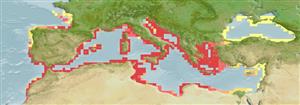>
Eupercaria/misc (Various families in series Eupercaria) >
Labridae (Wrasses)
Etymology: Symphodus: Greek, syn, symphysis = grown together + Greek, odous = teeth (Ref. 45335).
More on author: Linnaeus.
Environment: milieu / climate zone / depth range / distribution range
Écologie
marin; saumâtre récifal; profondeur 1 - 50 m (Ref. 121253). Subtropical; 47°N - 21°N, 11°W - 42°E
Eastern Atlantic: Spain to Morocco including the Mediterranean and Black Sea.
Length at first maturity / Taille / Poids / Âge
Maturity: Lm 11.7, range 12 - 15.2 cm
Max length : 44.0 cm SL mâle / non sexé; (Ref. 3397); common length : 25.0 cm SL mâle / non sexé; (Ref. 3397); âge max. reporté: 15 années (Ref. 4742)
Épines dorsales (Total): 15; Rayons mous dorsaux (Total): 11; Épines anales 3; Rayons mous anaux: 12
Adults are found near rocks mainly in eel-grass beds, sometimes in salty lagoons. Often gregarious. Oviparous (Ref. 205). Nest of seaweed built and kept by male with one or more females spawning. Feed on sea urchins, ophiuroids, bivalves, shrimps and crabs (Ref. 4742). Rate of growth is slow (Ref. 4742). Undergoes sex reversal (Ref. 4742).
Oviparous (Ref. 205). One male makes a nest of seaweed for one or more females to spawn in (Ref. 4742). Undergoes sex reversal (Ref. 4742).
Quignard, J.-P. and A. Pras, 1986. Labridae. p. 919-942. In P.J.P. Whitehead, M.-L. Bauchot, J.-C. Hureau, J. Nielsen and E. Tortonese (eds.) Fishes of the north-eastern Atlantic and the Mediterranean. UNESCO, Paris. Vol. 2. (Ref. 4742)
Statut dans la liste rouge de l'IUCN (Ref. 130435)
Menace pour l'homme
Harmless
Utilisations par l'homme
Pêcheries: pêcheries vivrières; pêche sportive: oui; Aquarium: Commercial
Plus d'informations
RéférencesAquacultureProfil d'aquacultureSouchesGénétiqueElectrophoresesHéritabilitéPathologiesTraitementNutrientsMass conversion
Outils
Articles particuliers
Télécharger en XML
Sources Internet
Estimates based on models
Preferred temperature (Ref.
123201): 16.3 - 21.4, mean 18.9 °C (based on 116 cells).
Phylogenetic diversity index (Ref.
82804): PD
50 = 0.5005 [Uniqueness, from 0.5 = low to 2.0 = high].
Bayesian length-weight: a=0.00933 (0.00783 - 0.01112), b=3.04 (3.00 - 3.08), in cm total length, based on LWR estimates for this species (Ref.
93245).
Niveau trophique (Ref.
69278): 3.3 ±0.3 se; based on diet studies.
Résilience (Ref.
120179): Milieu, temps minimum de doublement de population : 1,4 à 4,4 années (K=0.25-0.89(?); tm=2-3; tmax=15).
Fishing Vulnerability (Ref.
59153): Moderate vulnerability (40 of 100).
Nutrients (Ref.
124155): Calcium = 27.3 [12.3, 58.4] mg/100g; Iron = 0.547 [0.298, 1.074] mg/100g; Protein = 19.5 [16.6, 21.7] %; Omega3 = 0.22 [0.13, 0.38] g/100g; Selenium = 14.8 [7.1, 28.4] μg/100g; VitaminA = 50.1 [14.3, 214.1] μg/100g; Zinc = 1.02 [0.67, 1.79] mg/100g (wet weight);
